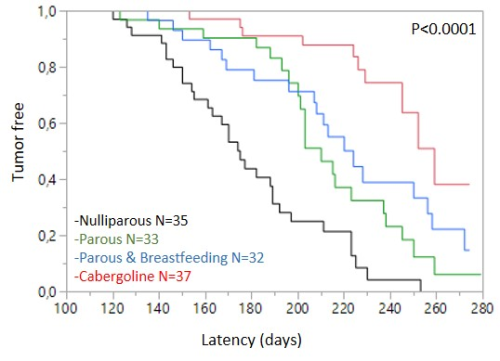Cabergoline and breast cancer chemoprevention
Cabergoline potentiates the protective effect against breast cancer in mice Age is the epidemiological factor that most influences the incidence of breast cancer. Early first-term pregnancy decreases the risk of breast cancer, but a global increase in breast cancer incidence is expected due to the increased aging of the population, and late first pregnancies, often after 35 years, avoiding the natural protective effect of pregnancy. Currently, there are only two alternatives to prevent breast cancer: breast amputation surgery and chemoprevention based on estrogen-receptor modulators. The latter produces important side effects such as thromboembolisms or endometrial cancer. Chemoprevention strategies with fewer side effects and less aggression are then needed.
We demonstrated that treatment with a single dose of cabergoline at weaning in a mouse model deficient in Brca1/P53 in the mammary gland increased latency and decreased breast cancer incidence, since cabergoline increased the percentage of apoptotic cells and adipose tissue in the early phase of post-lactational involution. Moreover, in the long-term follow-up, cabergoline decreased epithelial proliferation and the ductal epithelial area.
These results suggest that cabergoline could be a valuable drug for breast cancer chemoprevention after pregnancy.
Main innovations and advantages
- Cabergoline is more comfortable to be administered (one dose after weaning) than current chemoprevention drugs (daily intake).
- Cabergoline has fewer side effects than current drugs, favoring adherence to this treatment · Another chemopreventive drugs ara often abandoned in the first year due to annoying side effects).
- All these features make cabergoline a valuable drug for the growing demand for chemoprevention in our society because of social changes in an increasingly aging society where the first child is often had after the age of 35, incresing breast cancer risk.
- New machine learning strategies for image analysis will soon allow women at risk of breast cancer to be better identified in mammograms and
- MRIs.






